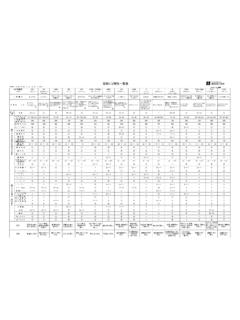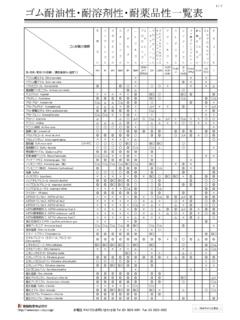Transcription of 102% ATOFINA LUPEROX A4 INTERIE - ФИТгрупп
1 ORGANIC PEROXIDES. Crosslinking rubber, elastomer and polyethylene Table of contents 3 The worldwide trademark 4 Peroxides and polymers 5 Physico-chemical properties & chemical structures 6 Kinetic data 7 to 9 Selection 2. 10 Performances 11 Influence of compounding additives 12 to 13 LUPEROX range 14 to 15 Safety - Handling - Storage Research center of Lyon A global chemical player, Arkema consists of 3 coherent and balanced business segments: Vinyl Products: Chlorochemicals and PVC,Vinyl Compounds, 3. Pipes and Profiles. Industrial Chemicals: Acrylics, PMMA, Thiochemicals, Fluorochemicals, Hydrogen Peroxide. Performance Products: Technical Polymers, Specialty Chemicals, Organic Peroxides,Additives, Urea Formaldehyde Resins, Agrochemicals. Arkema develops its activities by combining safety and environmental protection, client proximity, industrial reliability, and competitiveness. Present in over 40 countries with 18,600 employees, Arkema achieves sales of billion euros.
2 With its six research centers in France, the United States and Japan, and internationally recognized brands, Arkema holds leadership positions in its principal markets. Research center of Philadelphia LUPEROX . Organic Peroxides and polymers Peroxides crosslinking Polymers which can be crosslinked with Organic Peroxides Organic Peroxides can be thermally decomposed to generate free radicals which can subsequently create an active site on a polymer backbone. The ABS Acrylonitrile butadiene styrene copolymer reaction between two active sites will create a AU/EU Polyurethane rubber BR Polybutadiene rubber strong link between the polymer chains, leading CM Chlorinated polyethylene to a polymer network exhibiting very desirable CR Polychloroprene rubber mechanical properties, in particular excellent heat CSM Chlorosulfonyl polyethylene resistance and compression set. Among the other EBA Ethylene butylacrylate copolymer advantages offered by Organic Peroxides versus EPM Ethylene propylene copolymer sulfur vulcanization is the wide range of polymers EPDM Ethylene propylene diene terpolymer which can be crosslinked (unsaturated polymers EVA Ethylene vinylacetate copolymer as well as saturated polymers like polyethylene).
3 FPM Fluoro rubber Due to the nature of the strong carbon-carbon HNBR Hydrogenated butadiene acrylonitrile rubber crosslink bond created by the use of Organic IR Polyisoprene rubber Peroxides, it is possible to utilize the full engineer- NBR Butadiene acrylonitrile rubber NR Natural rubber ing capabilities of these peroxide crosslinkable PE Polyethylene polymers. POE Polyolefin elastomer Q Silicone rubber SBR Styrene butadiene rubber T Polysulfide rubber EEA Ethylene ethyl acrylate 4. Polymers which can not be crosslinked with Organic Peroxides ACM Polyacrylate rubber MASTERBATCH. CIIR Chlorobutyl rubber IN PELLETS. CO Epichlorohydrin rubber ECO Epichlorohydrin copolymer IIR Butyl rubber PB Polybutene-1. PIB Polyisobutene PVC Polyvinylchloride GRANULES PP Polypropylene Suggested technology to mix with LUPEROX Organic Peroxides liquid powder masterbatch or liquefiable granules grades grades POWDER grades absorption on polymer + - - - internal mixer - + + +.
4 CRYSTALS open mill - + - +. direct extruder injection + - - - direct screw compounding without injection - - - +. LUPEROX Organic Peroxide Physico-chemical properties and chemical structures for the key crosslinking peroxides LUPEROX F. 1,3 1,4-Bis(tert-butylperoxyisopropyl)benzen e CH3 CH3. Cas N 25155-25-3 CH3 CH3. C O O C CH3. Molecular weight: g CH3 C O O C. CH3 CH3. Melting point: 41 C CH3 CH3. Active oxygen: %. LUPEROX DC. Dicumyl peroxide Cas N 80-43-3 CH3 CH3. C O O C. Molecular weight: g Melting point: 39 C CH3 CH3. Active oxygen: %. LUPEROX 801. tert-butylcumylperoxide CH3 CH3. Cas N 3457-61-2. C O O C CH3 5. Molecular weight: g CH3 CH3. Melting point*: 6 C. Active oxygen: %. LUPEROX 101. 2,5-dimethyl-2,5-di-(tert-butylperoxy)he xane CH3 CH3 CH3 CH3. Cas N 78-63-7. CH3 C O O C CH2 CH2 C O O C CH3. Molecular weight: g CH3 CH3 CH3 CH3. Melting point*: 5 C. Active oxygen: %. CH3 CH3 CH3. LUPEROX 230. n-butyl-4,4'-di(tert-butylperoxy)valerat e CH3 C O O C O O C CH3.
5 Cas N 995-33-5 CH3 CH2 CH3. Molecular weight: g CH2. Active oxygen: % C O (CH2)3 CH3. Note: this product exists only as extended grade O. LUPEROX 231 CH3 CH3. 1,1'-di(tert-butylperoxy)-3,3,5-trimethy lcyclohexane CH3 C O O O O C CH3. Cas N 6731-36-8. CH3 CH3. Molecular weight: g Active oxygen: % CH3. CH3. Note: this product exists only as extended grade CH3. Note*: these products exhibit supercooling phenomena in a wide range of temperature below melting point, the product can be stored for a period of time below the melting point and remain liquid. Kinetic data Half-Life Time The half-life of a peroxide at any specified temperature is the time required at that temperature to affect a loss of one half of the peroxide's active oxygen content. The rate of crosslinking produced by a free radical initiator will be determined by its rate of thermal decomposition. Half-life data is essential for selecting the optimum initiator for specific time-temperature applications.
6 Peroxide half-life data are generated by studying their thermal decomposition in various solvents at low concen- trations. The polarity of the solvent used in these studies will influence the peroxide decompo- sition kinetics. Thus it is important to compare peroxide half-life data generated in the same solvent and at the same concentration and, preferably when the initiators are of the same class. Producers of initiators and their customers roughly correlate the thermal stability of initia- tors with temperature. It is useful to express Examples: In a fixed time of 1 minute, 50% of LUPEROX 231 is decomposed this stability in terms of 1 min, 1 hr and 10 hrs at 155 C. half-life temperatures, , the temperatures at The same time is required to decompose 50% of LUPEROX DC at 180 C. 6. which 50% of the initiator has decomposed in At a fixed temperature of 170 C, about 2 min 40 s are necessary to decompose 1 min, 1 hr and 10 hrs, respectively. half of LUPEROX F.
7 Half-Life Time vs Temperature in n-decane/n-dodecane 100 000. Time (s). 10 Hours 10 000. 1 Hour 1 000. 100. 1 Minute 10. 1. 120 140 160 180 200 220 240. Temperature ( C). LUPEROX 231 LUPEROX F. LUPEROX 230 LUPEROX 101. LUPEROX DC LUPEROX 801. Selection LUPEROX Organic Peroxide dosage level recommendations in phr*. for various crosslinkable polymers and elastomers. Dosage of LUPEROX Organic Peroxides in some polymers. phr of active substance LUPEROX LUPEROX LUPEROX LUPEROX LUPEROX LUPEROX . F DC 101 801 230 231. LDPE. Low density polyethylene - - HDPE. High density polyethylene - - - - - 7. EVA. Ethyl-vinyl acetate EPM/EPDM. Ethylene-propylene monomers - CM. Chlorinated polyethylene - Q. Silicone rubber - - - NBR. Butadiene acrylonitrile rubber - SBR. Styrene butadiene rubber - Example: Typically, to phr of LUPEROX F are used in an EPM/EPDM compound. For a formulated peroxide, this quantity has to be divided by the peroxide content. Therefore, 4 to 8 phr of LUPEROX F40 is the typical range of quantities utilized for an EPM/EPDM compound.
8 Note*: part per hundred rubber - The phr values are based on a pure basis for each peroxide. When using a lower assay, extended grades, one must adjust the quantity of the grade considered. Please see the example provided above. Selection Suggested maximum compounding temperature Example: The suggested maximum compounding temperature is the temperature at which the scorch time (tS05 )* is equal to 5 minutes. If this temperature is exceeded during compounding the peroxide could decompose and lead to undesired crosslinking. 190. Temperature ( C). 170. 150. 145 145. 140. 130. 130. 110. 110. 105. 90. 8. 70. 101 801 F DC 230 231. X O X O X X X X. RO ER ER RO RO RO. PE P P E PE PE. LU LU LU LUP LU LU. Suggested curing temperature range Example: It is recommended to cure a polymer with LUPEROX F. at a temperature between 160 C and 210 C. Temperature ( C). 220. 200. 180. 160. 140. 120. 100. 101 801 F DC 230 231. X X X X X X. RO RO RO RO RO RO. PE PE PE E PE PE.
9 LU LU LU LUP LU LU. Note*: see page 10 for definition. Selection Suggested compounding time in rubber industry Experiments were performed with an EPDM compound in a Brabender type internal mixer. Standard deviation of MH was determined using an ODR2000E. rheometer after different times of compounding. The times reported in this graph are the mixing times required to obtain an acceptable standard deviation in MH from batch to batch, comparing the various commercially available forms of di-(t-butylperoxy)diisopropylbenzene. Pre-dispersed peroxide masterbatches dramatically shorten mixing time and improve the quality of the elastomer by avoiding premature crosslinking or scorch in hard or soft compounds. The final elastomeric composition exhibits a desirably lower and more consistent viscosity, essential to molding and extrusion operations. Consistency in the final physical properties of crosslinked technical articles is 9. obtained via these peroxide masterbatches, as they create factory compounds with an exceptionally uniform peroxide dispersion.
10 Example: Peroxides in masterbatch form like LUPEROX F40ED. significantly reduce the compounding time in hard and soft compounds. 200. Time (s). 180. 160. 140. 120. 100. 80. 60. 40. 20. 0. es es des rad es tch ra et g rad terba der g pell dg Mas Pow Hard Liqui Soft compounds shore A< 55. Hard compounds shore A> 55. Performances Processing time information Example: If an EPDM compound containing LUPEROX F is processed at 130 C, its viscosity will be increased by 5 Mooney Units after about 10 minutes. Experimental data were generated using a Mooney viscometer. tS05 is the scorch time at the Mooney Scorch tS05 vs Temperature in an EPDM compound processing temperature (usually at the polymer 25:00. extrusion temperature). This value represents the time during which the vulcanizable compound can be safely processed before unwanted crosslinking or scorch takes place. tS05 is defined 20:00. as the time needed at a specific temperature to obtain a 5 Mooney Unit increase in the viscosity as measured from the MV or minimum viscosity.




